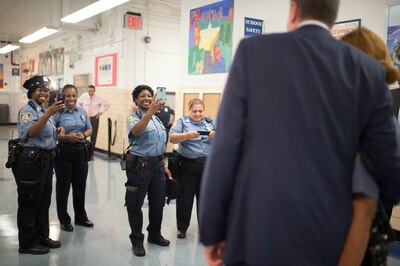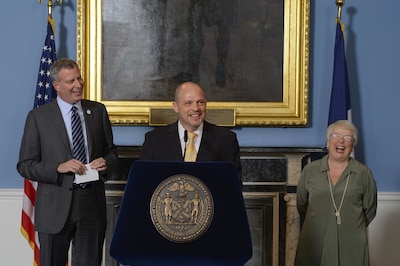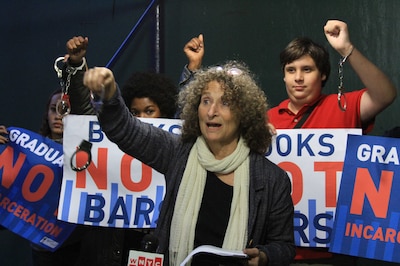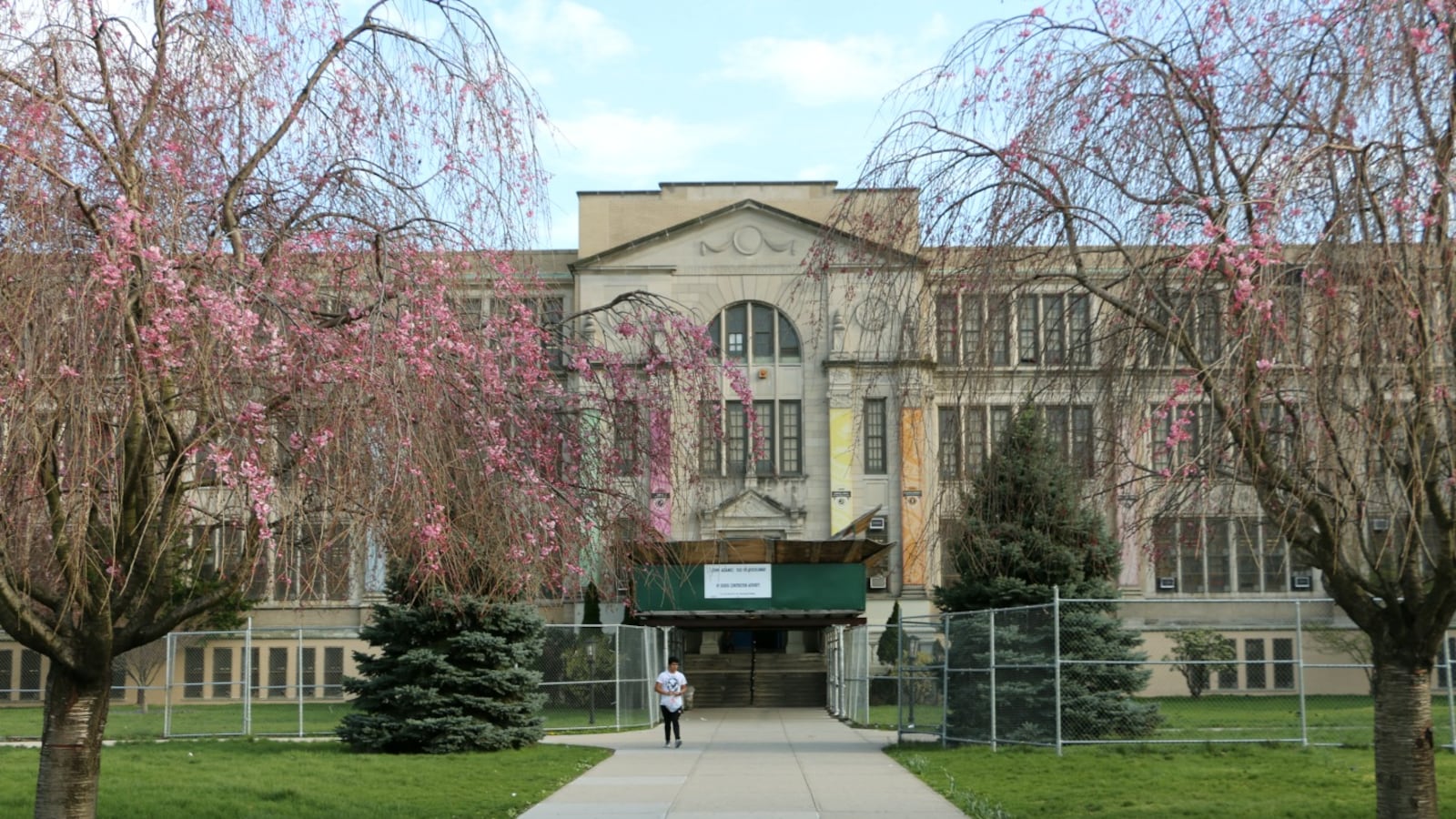From the outside, John Adams High School in Queens looks like a poster child for New York City’s new approach to student discipline.
The number of students given out-of-school suspensions plummeted from 382 in 2011 to just 28 in 2014, according to state records. A new behavior system rewards good deeds with bright green “Rack ‘Em Up” tickets, and fighting results in peer mediation and apology letters. Last year, a group of educators traveled from the Netherlands to observe the system.
But several teachers at the large Ozone Park school say the changes mask serious and persistent problems with student behavior. During a single week in March, one student was found unconscious on the school’s front steps after using drugs, another student was caught with a marijuana pipe, and several students erupted into a physical altercation in a hallway, according to a school log.
Though such incidents aren’t new or rare at many large high schools, some teachers at John Adams pin the misbehavior partly on recent changes in the city discipline code that restrict the use of suspensions. And as Mayor Bill de Blasio pushes schools to find alternative responses, the teachers say that administrators are increasingly wary about racking up high suspension counts.
At a meeting this week at John Adams, which is under city and state pressure to make major improvements, the school’s union representative told teachers said she believed the principal was not suspending students for serious infractions because “that makes their numbers look bad,” according to an audio recording. But she said the problem goes beyond Adams’ leaders.
“This is the problem right here: That the regulations are too lenient,” she said, holding up a copy of the city’s revised discipline code. “It does go from parent conferences to expulsion, but it’s never getting to the expulsion stage. It’s never even getting to the suspension stage.”
Such complaints by teachers at John Adams and elsewhere could spell trouble for Mayor Bill de Blasio’s effort to overhaul the way the school system handles misbehavior — a policy shift that must be enacted school by school, by individual educators, and which is already under assault by pro-charter school groups that say traditional schools have become more dangerous under de Blasio.
When the mayor announced the new discipline policies early last year, he insisted that schools could suspend fewer students while remaining safe and orderly. Since then, suspensions have fallen by nearly a third — a trend officials hold up as evidence that the discipline shift is taking root.
But some educators are questioning that narrative.
Teachers at a few schools say their principals won’t give suspensions even when warranted, inviting some students to act out and threatening their peers’ learning and even safety. Meanwhile, the principals union has suggested that the policies diminish principals’ discretion. And the head of the teachers union, the mayor’s staunch ally on most issues, has brought concerns about the policy’s rollout to the schools chancellor.
Even fierce proponents of the policy change worry that schools have not received the necessary support to transform their discipline practices.
“Schools need to stop the over-reliance on punitive discipline,” said Anna Bean, campaign coordinator for Teachers Unite, an educator-led advocacy group that backs the policy changes. “But a lot of schools are definitely struggling with what do we do instead.”
A message from the top
Cities across the country have pivoted away from suspensions and arrests for nonviolent school offenses in recent years, fueled by research showing such “zero-tolerance” policies tend to disproportionately affect students of color and often fail to improve student behavior. While those numbers have been on the decline in New York City for several years, the de Blasio administration has made clear that they must fall even further.
In February 2015, the city revised the discipline code so that principals now need approval before suspending students for insubordination. Out-of-school suspensions are no longer allowed in response to altercations that involve shoving, throwing objects, or spitting. Officials also vowed to restrict the use of suspensions and handcuffs on young children.

But even when the code permits suspensions, principals are said to be under pressure to consider other options. Teachers say that district officials are more frequently rejecting schools’ requests for more serious, out-of-school suspensions, and principals union leaders say schools’ overall suspension figures are under heightened scrutiny.
“There’s a heck of a lot closer attention being paid now to the numbers of suspensions that people are doing,” said Council of School Supervisors and Administrators Executive Vice President Mark Cannizzaro, adding that some principals feel their discretion has been “compromised.” “People are being called out when their numbers are at a point that someone determines as high.”
Advocates and even the union officials say that some oversight is justified, and that alternative responses can work better than suspensions.
But some teachers argue that principals are declining to give out-of-school suspensions even when the discipline code calls for them because they doubt that department officials will give their approval. Instead, they rely on other consequences or shorter suspensions that typically keep students in school.
During a fight at a small high school inside the Christopher Columbus campus in the Bronx last month, a student tried to stab another boy with a pair of scissors, according to a teacher there. The discipline code, which describes scissors as a “category II” weapon, lists an out-of-school suspension as the minimum recommended consequence for an attempted attack with such weapons.
However, the school recorded the incident as reckless behavior, a less serious infraction that allowed for an in-school suspension, according to the teacher. When challenged, the principal told the teacher that the district’s safety official would likely have rejected the request for an out-of-school suspension. Soon after, several teachers filed a safety complaint with their union. (An education department spokeswoman said she could not comment on the incident.)
Christine Montera, a teacher at East Bronx Academy for the Future, a different Bronx school that serves grades 6-12, said she knew of several instances where the district office had denied her school’s request to issue out-of-school suspensions. She doesn’t believe it is fair or effective to suspend students for minor misbehavior, she said, but the new restrictions are creating new discipline problems.
Students get the sense that “if I do something and I didn’t get suspended for it, now I can get away with stuff,” she said. “That sense is spreading.”
Lois Herrera, who heads the city education department’s Office of Safety and Youth Development, said the city does not factor the number of suspensions into principal or school ratings so that schools feel free to use them when appropriate. However, she said that district officials do inquire about the severity of a student’s misbehavior and the school’s other intervention attempts before approving longer suspensions.
“We don’t want an over-reliance on suspensions,” Herrera said, calling that “the old way of doing business and a very punitive way of doing business.”
Seeking support
In place of suspensions, the city is prodding schools to rely more on interventions such as counseling, peer mediation, and behavior contracts, which officials and advocates say are more effective at preventing misbehavior and treating its root causes.
But there’s a catch: those practices demand more time and training. Instead of just sending students to the office, a “restorative” approach calls for staffers to help students analyze poor decisions, develop a bank of better choices, and apologize for harm they’ve caused.

Teachers at several schools said they have yet to receive training or to see school-wide systems of interventions and consequences to replace suspensions. Citywide, only a subset of schools has received training on restorative practices.
Many teachers at Lehman High School in the Bronx are uncertain about how to respond to serious behavior problems in light of the policy changes, said math teacher and union representative Jeffrey Greenberg. Staffers at the low-performing school were told to give lists of students who require emotional or academic support to the school’s nonprofit partner, but they are less sure what to do when students break rules during class that previously would have triggered a call to the dean and a suspension.
“In the old days, the kid would cross the line and [the administration] would take care of it,” he said. Now, “the line is not really clear.”
Advocates have long called for the city to fund on-site coordinators at schools to oversee the conferences, training, and conflict-resolution classes that well-run alternative discipline systems demand. But only 15 schools have received funding from City Council for those positions, and city officials said they have no plans to significantly expand the number of those coordinators.
At a teachers union meeting in January, 62 percent of the 414 school representatives who participated in a survey said their schools do not have enough staffers to intervene when students misbehave, and 80 percent said misbehavior was disrupting learning at their schools, according to a union report.
United Federation of Teachers President Michael Mulgrew has relayed concerns to Chancellor Carmen Fariña about principals who have nearly abandoned suspensions, as well as there being too little teacher training as schools transition to alternative systems.
“What are you going to do differently to make sure this important work is getting done,” Mulgrew said in an interview, referring to the education department, “and not just throwing it at schools?”
Department spokeswoman Toya Holness, who noted that crime in schools is down along with suspensions, said the city has funded 250 new guidance counselors over the past two years along with teacher training. The mayor’s preliminary budget in January included $47 million for school discipline initiatives, such as adding mental-health services, full-time social workers, and “culture coordinators” to schools with the highest suspension rates.
“We believe that we are on the right course,” said Herrera, the school safety official, “in terms of moving away from suspensions.”
Growing pains
Where some critics see the pendulum swinging too fast and far away from suspensions, proponents of the change chalk up those concerns to unavoidable growing pains as the country’s largest school system takes a radically different stance on school discipline.
The restrictions on suspensions for insubordination — such as cursing at a teacher or refusing to leave a classroom — have been an especially difficult transition for teachers, some administrators say. The teachers see those incidents as undermining their authority and allowing a student to disrupt learning for an entire group. In such cases, a phone call home or a meeting strikes some teachers as insufficient.

“A common complaint is that kids don’t know consequences,” said Mike Dunson, an assistant principal at Harvest Collegiate High School in Manhattan, which emphasizes restorative practices rather than suspensions. An insubordinate student may eventually face a “fairness” panel made up of students and staff or a mediation, but some teachers would prefer a more immediate, decisive response.
“I ask them what consequences are you talking about,” Dunson said, “and they don’t want to say ‘I mean suspensions,’ but that’s kind of what they mean.”
Donna Lieberman, executive director of the New York Civil Liberties Union and a member of a city task force on school safety, said the city must still do “an enormous amount of work” to help schools rely less on suspensions. But she said schools were already making adjustments on account of the policy change.
“A system that is decades in the making, even with the best of intentions and all the resources in the world,” she said, “doesn’t change overnight.”
John Adams’ principal, Daniel Scanlon, did not respond to a request for comment. An education department spokeswoman said that the school administration follows protocol when responding to incidents, and that the department has provided training to help the school use “guidance interventions” and other alternatives to suspension.
Outside the school last week, several students said they generally feel safe at the school and have noticed fewer fights this year. A few teachers said that any large school will have some serious incidents, and that John Adams’ positive-behavior system leaves suspension on the table even as it offers an assortment of other options.
“Every student is an individual, and they have to be dealt with on an individual basis,” said a teacher who gave only her first name, Patricia. “And I think our faculty and our staff and our administration do very well with that.”

